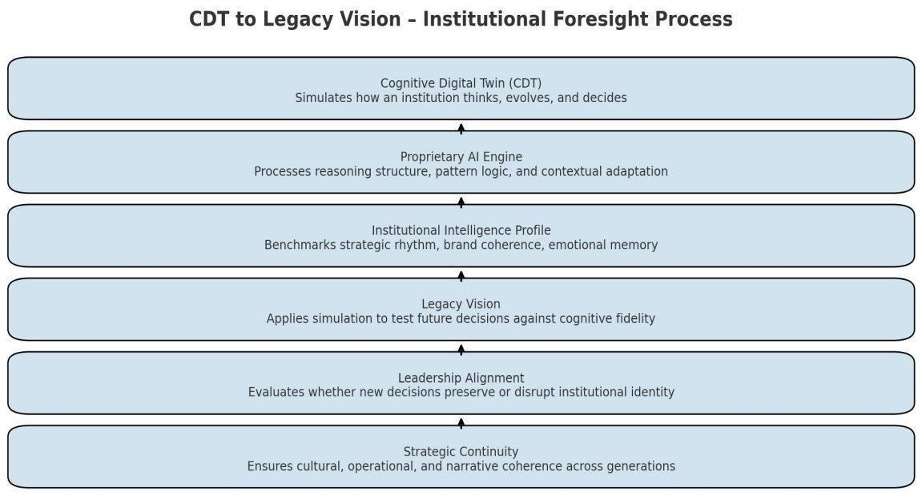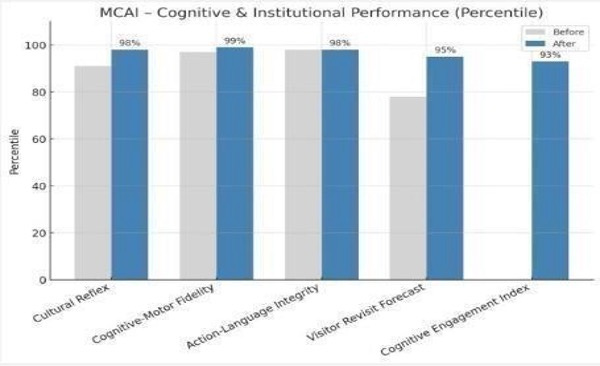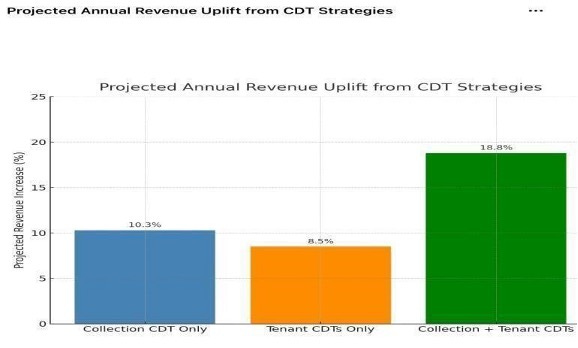MCAI Legacy Vision: Legacy Innovation and the Bellevue Collection
Embedding Foresight in the Foundations of the Collection's Future
MindCast AI (MCAI) doesn’t just simulate individuals—it models institutions as cognitive systems. By creating a Cognitive Digital Twin (CDT), MCAI captures how organizations think, evolve, and decide. This approach reveals the decision architecture behind growth, resilience, and risk exposure. Rather than tracking outcomes alone, MCAI models how institutions generate foresight, internal coherence, and long-term adaptability. It focuses not only on what decisions were made, but how they emerged from institutional reflexes, narrative tone, and emotional calibration.
The Bellevue Collection offers a rare example of this type of intelligence in action. Over 70 years, it has transitioned from a traditional shopping center into a region-defining mixed-use environment—curating not just products, but mood, memory, and meaning. It reads social cues, adjusts to demographic shifts, and evolves with generational expectations. That evolution is not reactive. It’s anticipatory. The Collection doesn’t simply respond to change— it forecasts it and translates those signals into architectural, operational, and cultural moves.
MCAI recognizes The Collection as an ideal candidate for LegacyVision—our applied model for institutions ready to test continuity, simulate future decisions, and evolve with cognitive integrity. LegacyVision helps leadership preserve what matters most: the invisible logic that made success possible in the first place. It turns institutional judgment into a model that can be evaluated, shared, and improved across leadership transitions. This isn’t about nostalgia—it’s about maintaining narrative and behavioral coherence through time and uncertainty.
At the core of LegacyVision is the concept of cognitive fidelity: the ability to retain and evolve the decision logic that defines institutional identity. With The Collection, that means understanding how brand selection, event programming, spatial flow, and civic presence all serve a unified emotional rhythm. It’s about testing whether future moves reinforce that rhythm—or interrupt it. Cognitive fidelity asks: will visitors feel the same continuity even as The Collection evolves?
MCAI calls this capacity competitive cognition: an institution’s ability to recognize emotional appetite, interpret cultural timing, and deliver experiences that are both timely and timeless. The Collection does not compete through volume or discounting. It competes through atmosphere, curation, and symbolic precision. Its success depends on coherence— in the physical space and the narrative intelligence. It knows how to read the room, own the room, and reinvent the room—without breaking the narrative that holds it together.
LegacyVision operationalizes that narrative. It turns memory into modeling. When leadership considers whether to add a rooftop event space, introduce a civic learning hub, or reconfigure luxury zoning, LegacyVision provides a simulation engine: one that goes beyond testing revenue by measuring alignment with institutional identity. It shows how decisions affect emotional memory, cultural positioning, and zone-based engagement. It’s not a forecast tool—it’s a strategic mirror. And it lets leaders see what they’re about to change before they’ve changed it.
Executive Summary
MCAI’s CDT analysis places The Collection in the 98th percentile for Action-Language Integrity (ALI), showing rare alignment between brand messaging and lived visitor experience. It ranks in the 97th percentile for Cognitive-Motor Fidelity (CMF), reflecting elite execution under complex and evolving market dynamics. The Collection also scores in the 93rd percentile on the Cognitive Engagement Index (CEI)—a measure that tracks how long people stay, how deeply they interact, and how much they emotionally retain. These scores do not reflect short-term performance. They reflect sustained institutional cognition over time.
LegacyVision translates these scores into strategic foresight. It helps decision-makers explore multiple futures while remaining anchored to what The Collection is. It ensures that as Bellevue expands into its next era—whether through new developments, tenant rotations, or global brand partnerships—it does so without losing the psychological and emotional identity it’s spent decades cultivating.
Future leadership can strengthen The Collection’s legacy by:
• Clarifying signals – turning complex data into actionable patterns
• Reinforcing vision – sustaining coherence over short cycles
• Curating brand alignment – selecting tenants that elevate identity
• Deepening civic role – embracing its place as a cultural anchor
LegacyVision makes meaning measurable. It turns culture into continuity and strategy into simulation. It’s more than preserving The Collection’s past. It’s about preparing its intelligence for the future.
Deep Dive
MCAI identified areas where it’s technology will be valuable to The Collection to sustain long term innovation. We outline the top four below.
¢ MCAI CDT + Forecasting Modules for Simulations
MCAI models what an institution has done, and how it can evolve. It simulates the underlying cognitive structure—how a space reads cultural signals, makes strategic choices, and maintains coherence over time.
We ran The Collection through this framework to test a focused concept: What happens when you introduce a one-week Rotating Innovation Display Zone, where a single brand (like TUMI, Salt & Straw, or Microsoft) steps into the spotlight—to sell, and to teach?
Each week, a new brand takes over the space—not with a pitch, but with a narrative. They share process, philosophy, sustainability practices, or technological insight. Visitors don’t just shop—they engage. They pause, ask, and remember.
The result is beyond novelty—it’s a behavioral shift.
MCAI Forecast (Center-Wide Impact):
• Foot traffic increase: +9–12%
• Dwell time increase: +14–18%
• Conversion lift: +7–11%
• Narrative memory retention: 67–72%
• Modeled revenue uplift: $500K–$690K per week
Confidence level: 85–92%, based on comparative benchmarks and behavioral simulation.
This isn’t about loyalty loops or repeat incentives. It’s about drawing in new visitors who wouldn’t have come that week—and keeping them on-site longer once they do. The format transforms curiosity into presence, and presence into performance.
It also reflects The Collection’s core intelligence: competing through culture, not commoditization.
This is how cognitive architecture becomes economic architecture. When a space teaches, remembers, and adapts, the returns aren’t just transactional. They’re strategic. By introducing a Rotating Innovation Display Zone, The Collection fortifies its cognitive engagement strength, making it a more well-rounded institution for the future.
¢ Simulating CDT Business Partners
Here’s what MCAI modeling shows when The Collection applies CDTs across its environment:
A CDT of The Collection itself improves strategic foresight—giving leadership the ability to forecast emotional drift, zone fatigue, and brand misalignment before those patterns surface in revenue data. The model detects when a space begins to lose coherence, when messaging starts to misalign with experience, and when energy drops below cognitive engagement thresholds.
This alone projects a +10.3% increase in annual revenue, driven by improved narrative pacing, emotional continuity, and optimized foot traffic distribution.
But the real opportunity emerges when CDTs are extended to tenants. Each brand can be modeled for its cognitive contribution—how it activates emotion, aligns with The Collection’s rhythm, and complements its neighbors. This enables predictive modeling of lease renewal decisions, tenant adjacency planning, and the early identification of cognitive misfits—well before performance data begins to flag risk.
Tenant-level CDTs add another +8.5% projected uplift, primarily through zone optimization and churn reduction. With both layers in place, The Collection evolves from a static commercial asset into a dynamic, thinking system.
Combined, these simulations yield a +18.8% total revenue uplift. The difference isn’t just operational—it’s architectural. Space planning becomes intelligence management.
The chart below reflects what happens when you stop reacting to what tenants have done— and start forecasting what they’re about to become.
The Bellevue Collection should do more than lease to brands. It thinks with them.
¢ Predicting Revenue Drops, Before They Hit the Register
For future risk analysis, The Collection can’t just rely on sales data. It must monitor nontransactional signals that indicate when engagement—and eventually revenue—are at risk of slipping.
Revenue doesn’t fall all at once. It unravels slowly, beginning with subtle shifts in behavior, attention, and spatial rhythm. That’s why behavioral forecasting matters. It identifies the cracks before they become visible in the financials.
This graph shows the top behavioral indicators most predictive of future revenue loss, based on The Collection’s profile and real-world data from mixed-use environments. Each factor reflects not what people buy—but how they feel, how long they stay, and whether the space still holds emotional and cognitive relevance.
The highest-weighted signals are emotional drift and dwell time compression. These indicators show that visitors are still arriving, but something has changed: they’re spending less time, engaging with fewer zones, and showing weaker emotional attachment. That’s when the breakdown begins—not in transactions, but in perception.
Other leading indicators include:
• Decline in Action-Language Integrity—when brand messaging no longer matches the lived experience
• Tenant-narrative misalignment—when adjacent brands or interior stories start to conflict • Reduced cognitive engagement and disrupted cultural rhythm—when people stop lingering, exploring, or remembering
MCAI simulations flag several milestones to monitor:
• Dwell time drops greater than 8% over two consecutive quarters
• Three or more tenant tone shifts in a single calendar year
• Visitor flow becomes overly linear—suggesting transactional focus rather than discovery
Loss doesn’t start with the numbers. It starts with the level of engagement fading. And the earlier leadership catches it, the more focused and strategic the response can be.
¢ LegacyVision
The Collection is the penultimate example of LegacyVision—a model of how long-term foresight, identity, and decision logic crystallized into an institutional intelligence that can be preserved, tested, and evolved.
This is not a static legacy. It is a living structure of thought and intention—one that shaped not only physical space but also cultural memory and regional identity. The Collection went beyond adapting to change; it anticipated it. It responded to consumer behavior shifts, competitive market pressure, and generational trends with remarkable consistency and emotional precision.
Future leaders can simulate their decisions against the CDT and intelligence profile that powered The Collection’s rise. This allows them to explore how new choices align—or conflict—with the core principles that have made The Collection resilient. It’s not about limiting innovation. It’s about ensuring that innovation evolves from a place of coherence.
LegacyVision creates a live benchmark for alignment. It allows leadership to ask:
• Are we evolving—or drifting?
• Reinforcing The Collection’s strengths—or editing them out?
• Introducing new intelligence—or weakening the original structure?
This isn’t about preserving tradition. It’s about knowing what worked, why it worked, and whether today’s decisions still honor the deeper architecture of judgment and design.
LegacyVision turns institutional memory into a strategic asset. It equips leaders with a mirror, a model, and a simulation tool to explore continuity before it’s lost. Continuity doesn’t mean staying the same. It means staying coherent—even while you change. It means leading forward, without leaving behind the intelligence that made you matter. MCAI figured out how to resolve this problem at scale with AI.
12-domains in The Collection LegacyVision study.
• Emotional Engagement & Dwell Time Dynamics. Track how long visitors stay and how deeply they engage—key to predicting retention and revenue resilience.
• Tenant Cognitive Fit & Renewal Simulation. Evaluate whether each tenant aligns with the Collection’s evolving identity before renewal decisions are made.
• Zone-Level Narrative Coherence. Ensure that each part of the Collection supports a unified emotional and spatial story.
• Experiential Programming Rhythm (Seasonal + Rotating). Model the cultural and behavioral timing of programs like Snowflake Lane and rotating exhibits.
• Civic Integration & Cultural Role. Test the Collection’s ability to operate as a civic anchor and cultural forum beyond retail.
• Visitor Cognitive Segmentation & Behavior Mapping. Profile visitor types by purpose, pace, and engagement level to optimize layout and messaging.
• Brand-Tone Consistency Across Tenants. Monitor narrative drift and stylistic misalignment at the tenant level.
• Cross-Zone Flow & Spatial Rhythm. Simulate foot traffic pathways to optimize exploration and reduce congestion or dead zones.
• Cultural Sentiment Calibration (Live + Online). Analyze visitor sentiment across channels to detect early shifts in perception or mood.
• Food & Experience-Driven Loyalty Levers. Measure the impact of dining zones and interactive elements on repeat visitation and dwell time.
• Architectural & Sensory Friction Mapping. Identify areas of overstimulation or disengagement to improve movement and comfort.
• Iconography & Memory Anchors. Evaluate symbolic touchpoints (art, views, lighting) that create lasting emotional associations.









